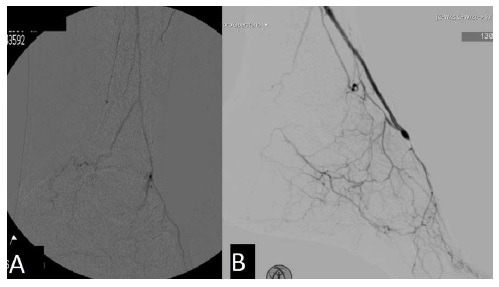Introduction
Peripheral bypass grafting is a surgical treatment for conditions as peripheral artery disease and acute limb ischemia.
The use of autologous veins has been proven to have better results compared to prosthetics grafts and is a key element for a successful vascular reconstruction1.
The great saphenous vein (GSV) is the first-choice conduit for infrainguinal bypass. However, there are situations where the GSV is not available or may be inappropriate to be used as a conduit.
The main option is to resort to small saphenous vein (SSV) or arm veins.
The SSV is frequently an underestimated resource and the number of studies using SSV as a conduit are few.
The small length and diameter often lower than 3mm excludes its use for infrainguinal bypass2.
However, its length could be an advantage if we want to perform an interposition bypass, surgical angioplasty or redo bypass.
In this paper, we present two cases of limb salvage procedures using the small saphenous vein as conduit and a literature review on the theme.
Clinical case descriptions are based on electronic hospital records and imagiologic exams.
Clinical cases
Case 1
A 69 years-old hypertensive, dyslipidemic male went to to the emergency room with an acute left lower limb ischemia. Ten months before he was submitted to a below the knee femoral- popliteal bypass with a 6mm heparin-bonded expanded polytetrafluoroethylene. He was on high dose statin (20mg rosuvastatin) and aspirin. On the physical exam only the left femoral pulse was present. Doppler ultrasound confirmed bypass occlusion. The patient was proposed for a catheter directed thrombolysis (alteplase, 1mg/hour) and 48 hours later the bypass was patent, but distally only with retrograde flow to above knee popliteal artery (figure 1A). The foot angiogram presented a patent pedal artery. He had had varicose veins surgery 11 years before with bilateral stripping of the great saphenous vein from the ankle to the groin. Some varicose veins were present in the leg and a patent small saphenous vein was found on the ultrasound of the leg. After general anesthesia was induced the pedal artery and the distal part of the graft were isolated. The small saphenous vein was harvested in supine position, with medial rotation of the leg. The small saphenous vein provided 30cm of conduit that was insufficient to extend from the below the knee previous bypass to the pedal artery. A straight segment of superficial medial vein in the leg was also harvested, adding extra 10cm of conduit. The patient’s lower left limb was scanned with ultrasound and no other vein was found to be compatible with bypass. A 10cm segment of expanded polytetrafluoroethylene was used to extend the previous bypass and sutured to the autologous conduit of small saphenous vein plus superficial vein. The vein was anastomosed distally to the pedal artery. The control angiogram is shown in figure 1B. After 3 days of inpatient post-operative care the patient was discharged home on aspirin plus new oral anticoagulant.
Case 2
A 67 years-old hypertensive, dyslipidemic, type 2 diabetic male, submitted two weeks before to a femoral-posterior tibial bypass with reversed great saphenous vein developed an infection at the distal anastomosis’ surgical site. After one week being treated with wound care and endovenous antibiotics, he had a bleeding event from the distal anastomosis, requiring emergent surgery with tight pneumatic tourniquet. After controlling the great saphenous vein proximal to the distal anastomosis and the posterior tibial artery, the small saphenous vein was harvested. A new distal incision over the posterior tibial artery and an interposition bypass with the small saphenous vein was performed. The previous posterior tibial approach was left open and later started negative pressure wound care. The incisions healed without any other complication. The patient was discharged on aspirin plus new oral anticoagulant (figure 2).
Discussion
Limb salvage surgeries often require a peripheral bypass and it's proven that an autologous vein has better results compared to prosthetic grafts3.
The great saphenous vein (GSV) is the most commonly used bypass conduit but up to 45% of patients do not have an available or unsuitable GSV4-6.
When an alternative to the GSV is required the small saphenous vein (SSV) seems to be an adequate alternative.
The SSV can withstand the higher pressure in the lower limbs and should be considered before the use of prosthetics grafts7.
Despite the length limitation of the SSV it can be used not only for short bypasses but also for bypass interposition sparing GSV for future bypass surgeries5.
According to Nierlich et al, SSV achieves excellent long term results in primary and redo procedures and has the advantage that harvesting is easy and rarely causes wound infections4.
In this paper, there are 2 cases where the SSV clearly was a limb salvage resort when other options were not available. In case 1, a patient with no other conduit for bypass needed a bypass extension to allow below the knee perfusion and in case 2 an emergency bailout to save the limb was needed using SSV.
In our two cases, the SSV showed to be an excellent alternative to limb salvage and no complications from wound’s harvesting or bypass interposition were seen.
















